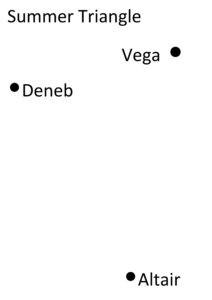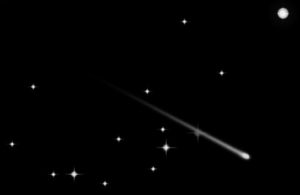The Sky in October
by Dee Sharples –
It may be fall but the Summer Triangle is a prominent asterism, or group of stars, that appears in the night sky. As the sky darkens, some of the firststars to come out are the three bright stars that form the Summer Triangle.
 Face south and look almost straight up to find bright Vega, part of the constellation Lyra the lyre. About 20 degrees (2 fist widths) east of Vega you’ll find Deneb, a star in the constellation Cygnus the swan. The third star Altair, in the constellation Aquila the eagle, can be found about 35 degrees (a little more than 3 fist widths) below Vega toward the horizon. Together they form a huge triangle in the sky that resembles a giant slice of pizza!
Face south and look almost straight up to find bright Vega, part of the constellation Lyra the lyre. About 20 degrees (2 fist widths) east of Vega you’ll find Deneb, a star in the constellation Cygnus the swan. The third star Altair, in the constellation Aquila the eagle, can be found about 35 degrees (a little more than 3 fist widths) below Vega toward the horizon. Together they form a huge triangle in the sky that resembles a giant slice of pizza!
If you’re an early riser, look for the planet Venus rising in the east before the sun comes up, looking like a dazzling jewel at magnitude -3.9. On October 5 the planet Mars, much dimmer at magnitude 1.8, will be very close to Venus separated by less than half a degree – that’s about half the width of a full Moon. Mars, also known as the red planet, will actually look like a reddish star compared to bright white Venus. On October 17 a slim crescent moon will join them in the early morning sky.
 The Orionid meteor shower peaks before dawn on October 21 when a rate of 20 meteors per hour is predicted. Dress warm and set up a comfortable chair facing southeast for your meteor watch any time between 2:00 AM and dawn. Meteors can appear anywhere in the sky but will seem to originate from the constellation Orion which is rising in the southeast. The meteor shower is active October 2 – November 7 so for several weeks you can see sporadic Orionid meteors shoot across the sky. But your chances of seeing the most meteors is at the peak when the light of the Moon won’t interfere and wash out the fainter ones.
The Orionid meteor shower peaks before dawn on October 21 when a rate of 20 meteors per hour is predicted. Dress warm and set up a comfortable chair facing southeast for your meteor watch any time between 2:00 AM and dawn. Meteors can appear anywhere in the sky but will seem to originate from the constellation Orion which is rising in the southeast. The meteor shower is active October 2 – November 7 so for several weeks you can see sporadic Orionid meteors shoot across the sky. But your chances of seeing the most meteors is at the peak when the light of the Moon won’t interfere and wash out the fainter ones.
This year marks the 40th anniversary of the launch of the two Voyager spacecraft which revealed the first detailed close-up views of the outer planets – Jupiter, Saturn, Uranus and Neptune. Launched within weeks of each other – Voyager 2 on August 20, 1977 and Voyager 1 on September 5, 1977 – both spacecraft followed the same trajectory all the way to Saturn and then went their separate ways.
NASA originally designed the mission for both spacecraft to only pass by Jupiter and Saturn. But after successfully flying by Saturn, NASA took advantage of a rare planetary alignment that occurs approximately every 175 years to send Voyager 2 onto Uranus and Neptune while Voyager 1 traveled away from the ecliptic plane, the path on which the planets travel around the Sun. This unusual planetary alignment allowed Voyager 2 to visit all four of the outer planets with a minimum amount of fuel and in a relatively short period of time.
Both Voyagers relayed back to Earth a treasure trove of previously unknown information: Jupiter, Uranus and Neptune had ring systems like Saturn but much fainter; Io, one of the four large moons of Jupiter, had actively erupting volcanoes; and each of those four giant planets had many small moons orbiting them which couldn’t be detected through Earth-based telescopes.
Each of the Voyager spacecraft carries a phonograph record, a 12-inch gold-plated copper disk, containing images and sounds of Earth, created for NASA by a committee chaired by Carl Sagan. Some of the sounds it includes are of nature such as wind, rain, thunder and the surf, laughter and a heartbeat, bird songs, music and greetings in 55 languages. Instructions, in symbolic language, describe how the record is to be played if ever encountered by an intelligent alien civilization. Carl Sagan referred to it as the “launching of a bottle into a cosmic ocean.”
Voyager 1 is now 13 billion miles from Earth and Voyager 2 is 11 billion miles away, but surprisingly both are still sending signals back to Earth.
 Dee Sharples is an amateur astronomer who enjoys observing planets, star clusters and the Moon through her telescope. She is a member of ASRAS (Astronomy Section of the Rochester Academy of Science) and records “Dee’s Sky This Month”, describing what can be seen in the sky, on the ASRAS website at rochesterastronomy.org. Watch for her monthly Owl Light News feature to learn more about the night sky.
Dee Sharples is an amateur astronomer who enjoys observing planets, star clusters and the Moon through her telescope. She is a member of ASRAS (Astronomy Section of the Rochester Academy of Science) and records “Dee’s Sky This Month”, describing what can be seen in the sky, on the ASRAS website at rochesterastronomy.org. Watch for her monthly Owl Light News feature to learn more about the night sky.